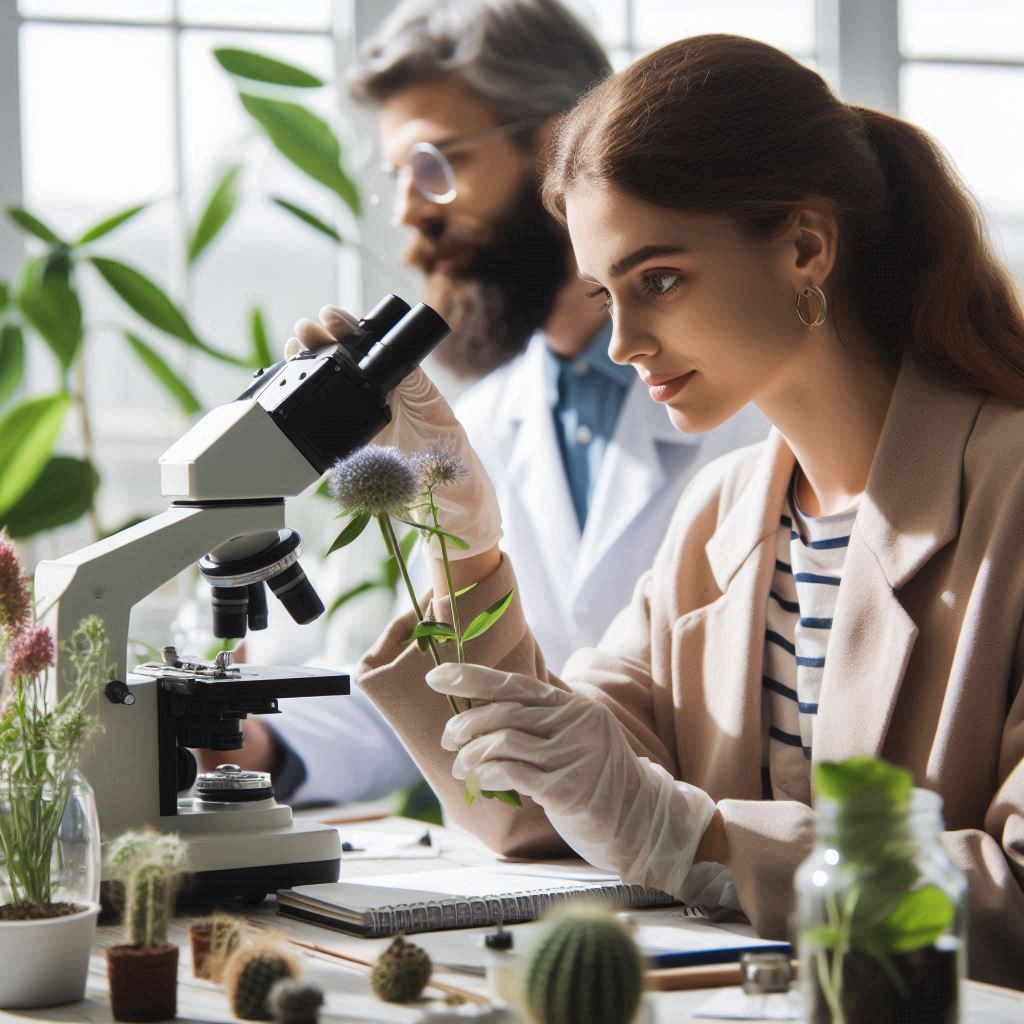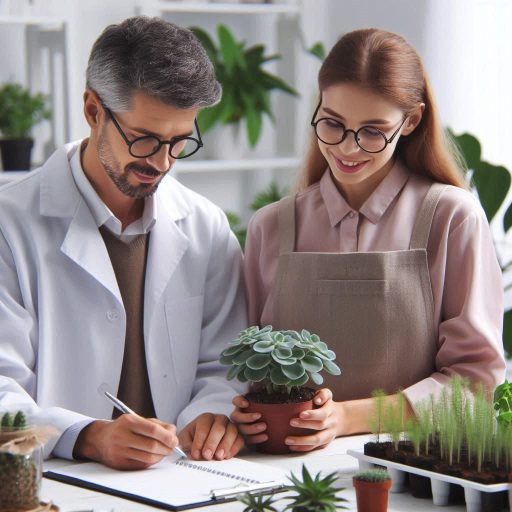Introduction
Field equipment is essential for botanists conducting research and collecting data in natural environments.
Proper tools enhance efficiency and accuracy during fieldwork.
Botanists rely on equipment to identify, collect, and document plant species effectively.
Having the right gear ensures they can analyze their findings accurately.
Every botanist should carry a field notebook for recording observations, sketches, and notes.
This notebook serves as a vital reference for later analysis and reporting.
A plant press is crucial for preserving specimens for further study.
It allows botanists to flatten and dry samples for accurate identification and long-term storage.
Hand lenses or magnifying glasses help examine small details on plants, such as leaf structures and flower anatomy.
Field guides assist botanists in identifying various species on-site.
These guides often contain illustrations and descriptions that aid in recognition.
A GPS device or smartphone with mapping apps helps botanists navigate and track locations.
It ensures they can revisit important sites and document their findings accurately.
Additionally, a sturdy backpack is necessary for transporting equipment and collected samples.
It should be comfortable and spacious enough to hold all essential gear while maintaining mobility.
A first aid kit ensures safety during outdoor excursions, addressing potential injuries or emergencies that may arise in remote areas.
Hand Lens or Magnifying Glass
Usefulness of a hand lens in examining plant details
A hand lens, or magnifying glass, is invaluable for botanists in the field.
It provides an easy way to inspect small plant details that may go unnoticed with the naked eye.
With a hand lens, you can observe intricate features such as trichomes, stomata, and leaf venation.
These details can help with species identification and understanding plant adaptations.
Using a hand lens can significantly improve the accuracy of your observations.
For instance, examining the surface texture of leaves can reveal important taxonomic information.
Additionally, a hand lens allows you to inspect flowers to determine characteristics crucial for identification, such as petal shape and arrangement.
Fieldwork often requires rapid assessments of various plant species.
The portability of a hand lens makes it a convenient choice for botanists on the go.
You can easily carry it in your pocket or backpack, ensuring it’s always accessible when needed.
This convenience encourages botanists to make more frequent and detailed observations during field surveys.
Tips on choosing the right magnifying glass for botanical fieldwork
When selecting a hand lens for botanical fieldwork, consider the magnification power.
Most botanists prefer lenses with magnifications between 5x and 10x.
This range provides a good balance between detail and ease of use.
Higher magnifications can make it difficult to focus on small areas, so find one that suits your needs.
Opt for a lens with a large diameter for a wider field of view.
A lens diameter of at least 30 mm allows for better visibility of larger plant structures.
Additionally, a lightweight design ensures you can carry it comfortably during long field excursions.
Material quality is another crucial factor.
Look for lenses made from high-quality glass for optimal clarity.
Plastic lenses may be lighter but can distort images, compromising your observations.
If possible, choose a lens with anti-scratch and anti-reflective coatings to enhance durability and visibility.
Consider the ergonomics of the hand lens as well.
A comfortable grip can make extended use much easier.
Some models even include built-in lights to illuminate your subjects, which can be especially helpful in dense vegetation or low-light conditions.
A hand lens is an indispensable tool for botanists, enhancing their ability to examine plant details closely.
By choosing the right magnifying glass, you can improve your fieldwork efficiency and accuracy.
Prioritize magnification, lens diameter, material quality, and ergonomics when making your selection.
With the right hand lens, you’ll be better equipped to conduct thorough and effective botanical research.
Field Notebook and Pens
Importance of Taking Notes and Sketching Plant Specimens
Taking detailed notes allows botanists to capture vital information about plant specimens.
Accurate documentation aids in identification, classification, and analysis of various species.
Recording data such as location, habitat, and growth conditions enhances the overall understanding of a plant‘s ecological role.
Sketching plant specimens further enriches this process.
Visual representations help botanists remember specific features of plants, such as leaf shapes, flower structures, and growth patterns.
Additionally, sketches serve as an excellent reference when back in the lab or during presentations.
These notes and sketches also provide a valuable historical record.
By documenting observations over time, botanists contribute to ongoing research and conservation efforts.
They create a wealth of information that can guide future studies and inspire others in the field.
Moreover, taking notes and creating sketches promotes mindfulness in botanical study.
The act of observing closely fosters a deeper appreciation for plant diversity and ecology.
This attentiveness enhances the overall experience of working in nature.
Suggestions for Durable and Waterproof Field Notebooks
Selecting the right notebook is crucial for effective fieldwork.
Botanists should opt for durable and waterproof field notebooks to withstand various outdoor conditions.
Exposure to moisture, mud, and rough handling can damage standard notebooks, compromising valuable data.
One excellent choice is the Rite in the Rain notebook.
This brand offers waterproof paper that withstands wet conditions.
Its rugged design allows botanists to work in rain, humidity, or even muddy environments without worrying about damaged notes.
Another reliable option is the Field Notes notebook.
While not fully waterproof, these notebooks feature sturdy covers and can endure light moisture.
Botanists can use them in combination with waterproof bags for added protection.
For those who prefer a more eco-friendly option, consider using recycled paper notebooks.
Several brands offer eco-friendly, durable, and water-resistant notebooks.
These choices provide an excellent balance of sustainability and functionality.
Investing in a good quality pen or pencil is essential.
Waterproof pens or pencils ensure that notes remain legible despite exposure to moisture.
Permanent markers can also help botanists label plant specimens or draw quick sketches directly in the field.
Read: US Chemistry Conferences and Symposiums to Attend in 2024
Plant Press
Botanists should have a plant press for collecting and preserving plant specimens effectively.
Why botanists need a plant press for collecting and preserving plant specimens
A plant press is essential for botanists because it allows them to preserve plant specimens for identification, research, and documentation.
When out in the field, botanists often come across rare or unique plant species that need to be carefully collected and preserved for further study.
Plant presses help botanists flatten and dry plant specimens quickly, which prevents them from decaying and losing their shape and color.
Having a plant press ensures that botanists can create a reference collection of plant specimens that can be used for educational purposes or scientific research.
Types of plant presses available and how to use them effectively
There are several types of plant presses available, each designed for specific purposes and preferences
- Traditional wooden plant press: This press consists of two boards with straps.
It compresses plant specimens between layers of cardboard and blotting paper. - Microwave plant press: A modern alternative that uses a microwave to dry and press plant specimens quickly.
- Plant press kits: These kits include pre-cut cardboard, blotting paper, and straps for assembling a plant press on the go.
- Homemade plant press: Botanists can also create their plant press using materials like heavy books, cardboard, and wax paper.
How to use a plant press effectively
Here are some tips on how to use a plant press effectively for collecting and preserving plant specimens
- Collect plant specimens carefully, making sure to include leaves, flowers, stems, and roots for identification purposes.
- Place the plant specimen between two layers of blotting paper inside the plant press.
- Add cardboard layers on top and bottom of the specimen to provide support during pressing.
- Tighten the straps or secure the press to ensure even and consistent pressure on the plant specimen.
- Check the plant press periodically to replace the blotting paper as needed and adjust the tightness of the straps.
- Leave the plant specimen in the press for a few days to allow it to dry completely before removing it for storage or mounting.
With a plant press, botanists enhance their fieldwork and research.
They create valuable collections of plant specimens for future reference.
Read: Key Roles and Responsibilities of a Chemist in the US
GPS Device or Compass
Importance of Navigation Tools for Botanists Exploring New Areas
Navigation tools are essential for botanists conducting research in remote locations.
These tools ensure that they can find their way through dense forests, wetlands, or mountainous regions.
In unfamiliar terrain, a botanist may encounter obstacles such as rivers, cliffs, or dense vegetation.
Having a reliable navigation system helps avoid getting lost and allows for more efficient data collection.
Accurate navigation also enhances the quality of research.
By reaching specific locations, botanists can conduct targeted studies on particular plant species.
This focus enables them to gather precise data on habitat preferences and plant distribution.
Understanding these factors is vital for conservation efforts and ecosystem management.
Moreover, navigation tools play a significant role in safety.
When exploring isolated areas, botanists may face various hazards, including adverse weather or wildlife encounters.
A dependable navigation system ensures they can find their way back to safety.
It also allows them to communicate their location to others, which is crucial during emergencies.
Reliable GPS Devices or Compasses for Fieldwork
Choosing the right navigation tools is essential for effective fieldwork.
GPS devices are invaluable for botanists as they provide accurate location information.
A reliable GPS unit should have features such as a long battery life and water resistance.
Additionally, it should work well in challenging environments, such as dense forests or mountainous areas.
Some highly recommended GPS devices include the Garmin GPSMAP series and the Magellan eXplorist series.
These devices offer excellent accuracy and durability for outdoor use.
They also provide preloaded maps, which can be beneficial for botanists unfamiliar with the area.
A good compass is another essential navigation tool.
While GPS devices are helpful, compasses do not rely on batteries and work in any weather condition.
A quality compass should have a clear dial, a sturdy construction, and a sighting mirror for accurate readings.
The Silva Ranger and Suunto MC-2 are popular compass choices among botanists.
These compasses provide reliable performance in the field and are user-friendly.
Botanists should also consider carrying a map of the area.
Maps can provide valuable context that GPS devices may not offer.
Read: Earning Potential: Chemist Salaries Across US States

Pruning Shears or Hand Pruners
Uses of Pruning Shears for Collecting Plant Samples
Pruning shears are crucial for collecting plant samples and specimens.
Their sharp blades allow for clean cuts, minimizing damage to the plant.
When collecting samples, clean cuts reduce the risk of introducing pathogens.
This practice helps preserve the integrity of the specimens for further analysis.
Botanists often use pruning shears to collect branches, leaves, or flowers.
They can easily access hard-to-reach areas and trim plants without causing harm.
Using the right type of pruning shears ensures that the samples are representative of the species.
In addition to specimen collection, pruning shears can help botanists manage plant populations.
Botanists often use them to remove invasive species.
They can efficiently cut down unwanted plants, allowing native species to thrive.
This practice is essential for maintaining healthy ecosystems.
Tips for Maintaining and Sharpening Pruning Shears for Longevity
Maintaining pruning shears is essential for ensuring their longevity and effectiveness. Proper care will keep them sharp and functional for years.
Here are some tips for maintaining and sharpening your shears
Transform Your Career Today
Unlock a personalized career strategy that drives real results. Get tailored advice and a roadmap designed just for you.
Start Now- Clean After Use: After each field session, wipe the blades with a clean cloth.
This removes sap, dirt, and debris that can cause rust. - Inspect Regularly: Check for any signs of wear or damage. Look for loose screws, bent blades, or rust spots.
Address any issues immediately to prevent further damage. - Sharpen Blades: Regularly sharpen the blades to maintain their cutting efficiency. Use a sharpening stone or file designed for pruning shears.
Angle the blade correctly while sharpening to achieve a smooth edge. - Oil the Blades: Apply a few drops of lightweight oil to the pivot point and blade edges.
This prevents rust and ensures smooth operation. Wipe away any excess oil to avoid attracting dirt. - Store Properly: Store pruning shears in a dry place, away from moisture.
Consider using a protective sheath or case to prevent accidental damage.
Proper storage helps maintain the sharpness of the blades. - Replace Worn Parts: If the springs or handles become damaged, consider replacing them.
Keeping your shears in top condition will enhance their performance. - Practice Safe Handling: Always use gloves while handling pruning shears to protect your hands.
Keep the shears closed when not in use to prevent accidental cuts.
Pruning shears are indispensable tools for botanists.
They facilitate the collection of plant samples and the management of plant populations.
By maintaining and sharpening your shears, you ensure their longevity and effectiveness.
These practices enhance your ability to conduct research and contribute to our understanding of plant diversity.
With proper care, your pruning shears will serve you well in your botanical endeavors.
Read: Continuous Learning: Post-graduate Options for US Biologists
Learn More: Navigating Soil Science Professional Organizations
Gain More Insights: Toxicology Research: Current Trends and Innovations
Field Bag or Backpack
Sturdy and comfortable field bag to carry equipment and specimens
When selecting a field bag, prioritize durability and comfort.
Look for bags made from high-quality materials that can withstand rough outdoor conditions.
A heavy-duty backpack or messenger bag with reinforced stitching will last longer during field expeditions.
Choose a bag that offers ample space for all essential equipment.
Botanists often carry items like field notebooks, identification guides, and collection tools.
Ensure the bag has enough compartments and pockets to organize everything neatly.
A well-organized bag prevents equipment from getting damaged or lost.
Comfort is equally important.
Look for bags that feature padded shoulder straps for added comfort during long hikes.
A breathable back panel can help reduce sweating and discomfort.
Opt for a bag with adjustable straps, allowing you to customize the fit according to your body size.
Features to look for in a field bag, such as waterproof material and adjustable straps
Several key features enhance the functionality of a field bag.
Waterproof material is essential for protecting your equipment from rain or accidental spills.
Look for bags made from high-quality, water-resistant fabrics to keep your items dry.
Consider bags with reinforced bottoms.
These can endure wear and tear from placing the bag on rough surfaces.
Some bags even come with a waterproof cover that provides extra protection during severe weather.
A bag with multiple compartments can help separate delicate specimens from tools.
Padded sections protect fragile items like plant samples or electronics.
Moreover, a front pocket for quick access to frequently used items can save valuable time.
Additionally, consider the bag’s weight.
A lightweight design ensures that you can carry it comfortably over long distances.
Some bags even include lightweight frames for added support without unnecessary bulk.
Lastly, check for additional features such as hydration pockets or external attachment points.
Hydration pockets allow you to carry water bottles, keeping you hydrated during your fieldwork.
External attachment points let you secure tools or other equipment, keeping your hands free.
In summary, a sturdy and comfortable field bag is essential for any botanist engaged in fieldwork.
Look for durable materials, waterproof features, and adjustable straps to ensure comfort.
By selecting a well-designed bag, you can effectively carry your equipment and specimens while focusing on your research.
The right field bag enhances your efficiency, making your botanical explorations enjoyable and successful.
Field Guide or Plant Identification Book
One essential piece of equipment that every botanist should have in the field is a reliable field guide or plant identification book.
This tool is crucial for accurately identifying plant species during fieldwork.
Importance of Having a Reference Guide for Identifying Plant Species in the Field
Having a reference guide for identifying plant species in the field is crucial for botanists and anyone interested in understanding plant life.
These guides serve as essential tools for accurately classifying plants encountered during research and exploration.
A reliable field guide provides detailed descriptions, images, and identification keys that help users recognize different species based on their unique characteristics.
Accurate identification is vital for botanists to document and study the plant species they come across in their research.
When botanists classify plants accurately, they collect and analyze data confidently.
This ensures their findings meaningfully contribute to botanical knowledge.
A reference guide also enhances fieldwork efficiency.
With a reliable guide, botanists can quickly compare the features of a plant with the descriptions provided, saving valuable time during field studies.
Having a reference guide for identifying plant species in the field is essential for ensuring accurate classification and documentation of plant biodiversity.
Such guides not only support individual research efforts but also contribute to a greater understanding of ecological dynamics and conservation strategies.
These guides prevent misidentification and promote efficient fieldwork.
They serve as invaluable resources that enhance botanical studies.
Additionally, they foster a deeper appreciation for the intricate web of life represented by plants.
Recommended field guides for botanists based on region or plant types
When choosing a field guide or plant identification book, it is important for botanists to consider the region in which they will be conducting their research.
Different regions have unique plant species, so selecting a guide specific to that area is key.
Field Guides by Region
- North America: Botanists in North America can benefit from field guides. “A Field Guide to Wildflowers of Northeastern.
North-Central North America” by Roger Tory Peterson and Margaret McKenny is particularly helpful. - Europe:Botanists in Europe rely on “Wild Flowers of Britain and Europe” by Wolfgang Lippert and Dieter Podlech.
This guide comprehensively covers the region’s diverse flora. - Asia: Botanists in Asia can benefit from guides like “A Field Guide to the Flowers of the Himalayas” by Oleg Polunin and Adam Stainton.
This resource helps them identify plant species in this unique mountain region. - South America: “Field Guide to the Plants of Northern South America” by James A. Duke and Elias Landolt serves as a valuable resource.
Botanists conducting research in South America’s diverse ecosystems will find it especially useful.
These are just a few examples of field guides that botanists can use based on their region of study.
It is important for botanists to research and invest in a quality field guide that aligns with the plant species they are likely to encounter in the field.
Overall, having a field guide or plant identification book is a must-have for botanists conducting fieldwork.
This tool serves as a valuable reference for accurately identifying plant species, contributing to the success and integrity of botanical research.
Conclusion
As a botanist, having the right field equipment is crucial for successful fieldwork.
Investing in quality tools ensures accurate data collection and enhances overall research outcomes.
Every botanist should carry essential field equipment.
A reliable GPS device helps with navigation and a sturdy magnifying lens allows for close examination of plants.
A durable field notebook is vital for recording observations.
Wear appropriate clothing for varying outdoor conditions.
Keep a compact first aid kit on hand for emergencies.
By equipping yourself with these essential tools, you can navigate through various terrains, observe plant specimens with precision, record important data efficiently.
Stay safe during fieldwork, and ultimately contribute valuable insights to the field of botany.
Remember, your field equipment is your partner in exploring the wonders of the natural world and conducting research effectively.
So, prioritize getting the right gear and maintaining it well to support your botanical endeavors.
Investment in quality equipment pays off in the long run, helping you achieve your research goals and make significant contributions to botanical science.
Stay prepared, stay equipped, and continue your botanical journey with confidence!
[E-Books for Sale]
The Big Book of 500 High-Paying Jobs in America: Unlock Your Earning Potential
$19.99 • 500 High-Paying Jobs • 330 pages
Explore 500 high-paying jobs in America and learn how to boost your career, earn more, and achieve success!
See All 500 High-Paying Jobs of this E-Book
1001 Professions Without a Degree: High-Paying American Jobs You Can Start Now
$19.99 • 1001 Professions Without a Degree • 174 pages
Discover 1001 high-paying jobs without a degree! Unlock career tips, skills, and success strategies for just $19.99!




